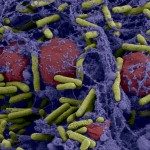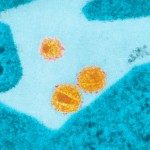Link to Pubmed [PMID] – 15761117
Mol. Pharmacol. 2005 Jun;67(6):1966-76
CC chemokine receptor 5 (CCR5) is a G protein-coupled receptor that governs migration of leukocytes and serves as a coreceptor for the R5 tropic strains of human immunodeficiency virus (HIV). CCR5-mediated signaling in response to CC chemokines relies on G protein activation. Desensitization, which rapidly turns off G protein-dependent signaling, involves phosphorylation of CCR5 that promotes interaction of the receptor with beta-arrestins for endocytosis. Whether coupling to G proteins, desensitization, and endocytosis of CCR5 require the same structural determinants remains a matter of investigation. Here, we show that CCR5 displayed agonist-independent coupling to G proteins. This constitutive activity of the receptor was abrogated by TAK779 (N,N-dimethyl-N-[4-[[[2-(4-methylphenyl)-6,7-dihydro-5H-benzocyclohepten-8-yl]carbonyl]amino]benzyl]tetrahydro-2H-pyran-4-aminium chloride), a nonpeptidic CCR5 ligand that inhibits HIV infection and was found to depend on the integrity of the Asp-Arg-Tyr (DRY) motif. Changing Arg-126 by the neutral residue Asn (R126N-CCR5 mutant) abolished CCR5-mediated activation of G proteins, either constitutively or in response to agonists. In contrast, R126N-CCR5 not only retained agonist-promoted phosphorylation and beta-arrestin-dependent endocytosis but also displayed a higher basal phosphorylation than wild-type CCR5. Expression of beta-arrestin in R126N-CCR5-expressing cells resulted in receptor down-regulation, thereby suggesting that R126N-CCR5 spontaneously interacts with beta-arrestins. However, although expression of beta-arrestin favored wild-type CCR5-mediated chemotaxis, it failed to promote migration of cells expressing R126N-CCR5. Overall, these data indicate that structural requirements for CCR5-mediated activation of G proteins, albeit not involved in receptor desensitization and internalization, are needed for beta-arrestin-mediated chemotaxis. These results have implications for how distinct biological responses of CCR5 might rely on a different set of receptor conformations.

